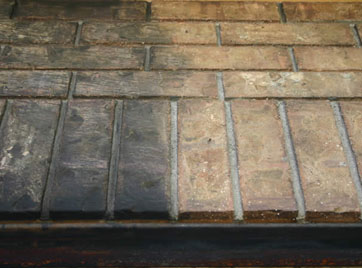Preparing the Fireplace for Cleaning
Before tackling soot buildup, take steps to protect the surrounding area. Lay down a drop cloth or old towels to catch debris, and wear gloves and a dust mask to avoid inhaling particles. Remove any loose ash or soot using a vacuum with a brush attachment. A dry scrub with a stiff-bristle brush can dislodge surface grime. Ensuring the bricks are free of excess dust before applying any cleaning solution makes the process more effective and prevents further staining.

Choosing the Right Cleaning Solution
Different cleaning solutions work depending on the severity of the soot stains. A simple mix of warm water and dish soap is effective for light residue. For tougher stains, a paste made of baking soda and water or equal parts vinegar and water can break down grime. Commercial soot removers offer a stronger option for stubborn buildup. Testing a small area first ensures the cleaner won’t damage the brick’s surface, especially if dealing with older or painted bricks.

Scrubbing Away Soot Stains
Once the cleaning solution is applied, use a scrub brush or sponge to work it into the bricks. Circular motions help lift stains without spreading them. For deep-set soot, allowing the cleaner to sit for 10–15 minutes before scrubbing improves results. If needed, repeat the process until the bricks regain their natural color. Avoid excessive water, as bricks are porous and can absorb moisture, leading to longer drying times and potential mildew growth.

Rinsing and Drying the Bricks
After scrubbing, wipe down the bricks with a damp cloth or sponge to remove any remaining cleaner. A gentle rinse using a spray bottle with clean water helps clear away residue without soaking the surface. Pat the bricks dry with a towel, then allow them to air dry completely before using the fireplace again. Proper drying prevents streaks and ensures that soot doesn’t cling to damp surfaces, keeping the fireplace looking fresh for longer.
:max_bytes(150000):strip_icc()/how-to-clean-fireplace-bricks-4587771-05-432c2920402c4265983d544f782af78e.jpg)
Preventing Future Buildup
Regular maintenance reduces the chances of soot accumulating again. Burning seasoned hardwood instead of softwood minimizes excess smoke and residue. Keeping the fireplace damper open during use improves airflow, helping soot escape instead of settling on bricks. Wiping the bricks with a dry cloth after each use prevents buildup from becoming difficult to remove. With routine care, the fireplace remains clean, safe, and ready for cozy nights by the fire.
How to Clean Fireplace Bricks – Simple Practical Beautiful

Quick n Brite Quick Cleaning Tips: How to Clean Fireplace Soot from Stone, Brick and Glass

Quick 4 Steps To Clean a Brick Fireplace with Scrubbing Bubbles – Home Guide Spot

White Swan Homes and Gardens: How To Clean Soot From Fireplace Brick
Quick n Brite Quick Cleaning Tips: How to Clean Fireplace Soot from Stone, Brick and Glass
Firestarter News by Earthcore: How do I Repair my Fireplace’s Fire Brick?
Samantha Uftring Lucas (mslucas25) on Pinterest

Related Posts: